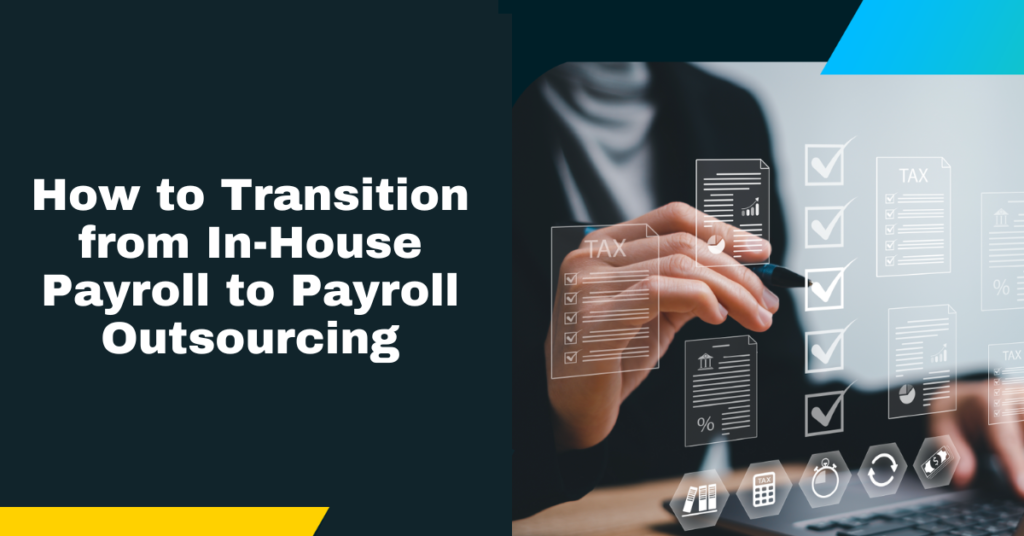As businesses grow, managing payroll in-house can become a challenging, time-consuming task. Companies often find that handling payroll internally diverts attention away from their core business operations, leading to inefficiencies. Transitioning to payroll outsourcing can be a game-changer, allowing businesses to focus on growth while experts handle payroll complexities. This article will guide you through the process of transitioning from in-house payroll to outsourcing, highlighting the role of payroll outsourcing companies and how they can ease the transition.
Assess the Need for Payroll Outsourcing
The first step in transitioning from in-house payroll to outsourcing is assessing whether it’s the right move for your business. Consider the following factors:
-Time and Resources: Does managing payroll in-house take too much time and effort away from your core business functions?
-Compliance Issues: Are you struggling to keep up with changing tax regulations and labor laws?
-Accuracy: Have you experienced errors in payroll processing that could harm employee satisfaction or result in penalties?
-Cost Efficiency: Is the cost of maintaining payroll software, staff, and compliance outweighing the benefits?
If any of these issues resonate with your business, it may be time to explore the benefits that payroll outsourcing companies can offer. Outsourcing not only saves time but also helps reduce the risks associated with non-compliance and payroll errors.
Choose the Right Payroll Outsourcing Company
Selecting the right payroll outsourcing company is crucial to the success of the transition. Payroll outsourcing companies in Chennai offer a variety of services, from basic payroll processing to handling tax filings and employee benefits administration. Here are some factors to consider when choosing the right partner:
-Experience and Expertise: Look for companies with a proven track record and expertise in payroll management. Consider whether they have experience working with businesses similar to yours.
-Compliance Management: Ensure the company has a strong understanding of local, state, and federal regulations to help you remain compliant.
-Technology and Software: The outsourcing company should use modern payroll software that can integrate with your existing systems and offer features like self-service portals for employees.
-Customer Support: Choose a company with reliable customer support that can address issues promptly and efficiently.
-Data Security: Payroll data is sensitive, so the company must have robust data protection protocols in place to ensure the confidentiality and security of your employees’ information.
The right payroll outsourcing company will not only handle your payroll processes efficiently but also reduce the administrative burden on your team.
Plan the Transition Process
Transitioning from in-house payroll to outsourcing requires careful planning to ensure a smooth process. Here are the key steps to follow:
-Evaluate Current Processes: Before handing over payroll responsibilities, thoroughly review your current payroll processes. Identify areas where you’ve encountered challenges and assess the data you need to transfer to the outsourcing company.
-Data Migration: Work with the payroll outsourcing company to securely migrate employee data, payroll records, and tax information. This step is crucial, as any discrepancies or missing data could lead to payroll errors.
-Set a Timeline: Establish a clear timeline for the transition. This includes deciding when the outsourcing company will take over payroll responsibilities and determining when in-house payroll operations will cease.
-Employee Communication: Notify your employees about the transition and how it will impact them. Inform them of any changes, such as how they will access their pay stubs or manage their tax forms. Clear communication helps ease any concerns employees may have during the transition.
Working closely with your chosen payroll outsourcing company during this phase is essential to ensure that everything runs smoothly.
Test and Review the Outsourcing Process
Before fully transitioning, conduct a test run with the payroll outsourcing company. This involves running parallel payroll processes, where both your in-house team and the outsourcing company process payroll for a pay period. This test allows you to identify any potential issues or discrepancies before fully committing to the outsourced system.
During this phase, closely monitor the accuracy of payroll data, tax withholdings, and benefits administration. Verify that the payroll outsourcing company is adhering to your compliance requirements and handling your employees’ payroll accurately and efficiently.
Fully Transition to Payroll Outsourcing
Once you’ve successfully tested the process and are confident in the payroll outsourcing company’s ability to manage your payroll, you can fully transition to outsourcing. The company will take over all payroll responsibilities, from calculating wages and processing payments to filing taxes and generating payroll reports.
At this point, your role will shift to overseeing the payroll outsourcing company’s performance and ensuring that they meet your business’s payroll needs. Regularly review their service to ensure continued accuracy, compliance, and efficiency.
Monitor and Maintain the Relationship
After transitioning to payroll outsourcing, it’s important to maintain an ongoing relationship with the outsourcing company. Regularly review their performance, communicate any changes in your business needs, and address any concerns promptly. Many payroll outsourcing companies offer flexible services, so if your business grows or your payroll needs change, they can adjust their services to meet your requirements.
Additionally, ensure that the payroll outsourcing company remains up to date with changing labor laws, tax regulations, and compliance requirements. Staying proactive helps avoid potential issues and keeps your payroll operations running smoothly.
Transitioning from in-house payroll to outsourcing can significantly streamline your payroll management and free up valuable time for your business to focus on growth. By partnering with the right payroll outsourcing company, you’ll reduce the risk of errors, ensure compliance with regulations, and gain access to expert support. Careful planning and a structured transition process are key to ensuring that your move to payroll outsourcing is successful.
Payroll outsourcing companies not only offer cost savings but also provide peace of mind by handling payroll complexities, allowing you to focus on what you do best—growing your business.



More Stories
Tax Benefits of Using Virtual Offices
What Are Industrial Cable Glands and How Do They Work?
Benefits of Reviewing PTE Mock Test Results